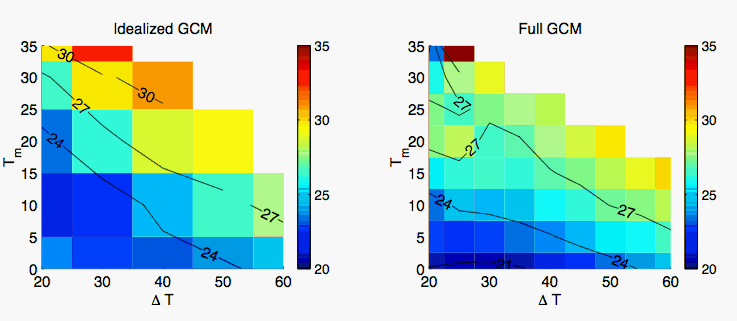Summary of The Width of the Hadley Circulation in Simple and Comprehensive General Circulation Models
by Frierson, Lu, and Chen, which appears
in Geophysical Research Letters.
 Primary arguments:
Primary arguments:
- An idealized moist GCM and a full GCM over aquaplanet boundary
conditions both show a similar expansion of the Hadley cell with
increased mean temperatures. This expansion is also of similar
magnitude to the expansion in coupled climate models with global
warming.
-
The Hadley cell expansion in both models scales well with a scaling
relation by Held (2000), which suggests that the increased static stability
in the subtropics may be the key reason for the poleward shift.
Discussion:
One of the most consistent responses of climate models to global warming
is a widening of the Hadley circulation. Since the downward branch of the
Hadley cell is associated with many of the largest deserts on Earth, the
poleward expansion of the Hadley cell also means a poleward expansion of the
dry zones. In climate models, the poleward expansion of the Hadley cell is
closely linked with the predicted drought in the Southwest US, the
Mediterranean, and other locations in similar latitude bands.
In this paper, to get a better idea of what causes this poleward
expansion, we examine simulations with two different models: the
idealized moist model that we originally introduced in
FHZ06, and a full
general circulation model such as those used for climate prediction. We
run these models over ocean-covered surfaces, with a wide range of ocean
temperatures, from extremely cold surfaces (with global mean temperature
of freezing), to extremely warm climates (with global mean temperatures of
35 Celsius, or 95 F). We also run over a wide range of pole-to-equator
temperature differences, from 20 to 60 C degrees. This wide range of
simulated climates gives us an idea of how the Hadley circulation can
change in response to increases in temperature and temperature gradient.
Over the entire range of climates considered and in both models, there is an
expansion of the Hadley cell with warmer temperatures, and also an expansion
with increased temperature gradients. We find that the expansion scales
quite well with a simple theory developed by Held (2000), which suggests that
the increase in subtropical static stability may be the key ingredient
causing the poleward shift. Increases in tropical static stability with
global warming is expected, but only recently has our research identified
that midlatitude static stability is also expected to increase (see
Frierson (2006).
For our other work on the poleward shift of the midlatitude jet stream with
global warming, see our other manuscripts (Lu et al and Chen et al).
For some research on the effect of a convection scheme on the Hadley
circulation, see Frierson
2007a. For another paper comparing the idealized GCM with the full
GCM simulations, this time about midlatitude static stability, see
Frierson 2007c.
The figure above shows the width of the Hadley circulation for 19
idealized GCM simulations (left) and 69 full GCM simulations (right). All
simulations are over aquaplanet, fixed SST boundary conditions, with the
global mean temperature on the y-axis, and the pole-to-equator temperature
gradient on the x-axis. Each rectangle represents one simulation. The
Hadley cell width increases with both mean temperature and the
pole-to-equator gradient.
Full citation:
Frierson, D. M. W., Lu, J. and G. Chen.
The Width of the Hadley Circulation in Simple and Comprehensive General Circulation Models.
In press, Geophysical Research Letters.
A PDF download of the full paper can be found here.
This download is courtesy of the American Geophysical Union, who owns sole
rights to it.
The download is subject to copyright laws and statutes. For more
information, please visit the AGU website.
|
|